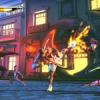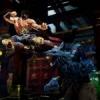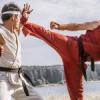Ultra Street Fighter IV, the fifth iteration of Capcom’s Street Fighter IV series is set to release on June 3rd. Featuring not only new characters, costumes, and stages, but also brand new game mechanics, it will be the biggest breath of fresh air the Street Fighter IV series has ever received. While fans in Japan and those lucky enough to have access to the test locations in the United States are already enjoying the arcade release, fighting game players around the world are lying in wait to get their hands on the game.
But how did we get all the way to Street Fighter IV? How did we get to a series that features over 40 games (one of which is still Capcom’s best selling game of all time), has multiple movies made in its honor, and whose most iconic characters are featured in everything from cologne to contraceptives to sneakers?
Origins - A new challenger enters the ring!
Towards the end of the 1980s, Capcom was looking to get into the business of making fighting games. Taking some inspiration from Konami’s 1985 Yie-Ar Kung Fu, Capcom’s Takashi Nishiyama and Hiroshi Matsumoto embarked on a project of their own, and in 1987, Street Fighter hit the arcades. You played as the wandering world warrior Ryu and were tasked with beating up anyone and everyone who stood in your way of becoming fighting champion of the whole darn world. If a real person challenged your supremacy, he or she would play as American pretty-boy Ken Masters who played almost identically to Ryu. In addition to Ken and Ryu, the game included several other characters who would make appearances in later titles such as Sagat, Birdie, and Adon.
Despite being innovative, Street Fighter left a lot to be desired. The game was horrendously balanced, special moves such as the Hadouken or Shoryuken capable of taking out massive chunks of your opponent’s health-that is, if you were able to execute them. While the cabinets featured the staple eight direction joystick (though it should be noted that it was criminally unresponsive), they lacked the six button format that would go on to be used by almost all fighting games going forward. Instead, you controlled your character’s punches and kicks with two bizarrely large buttons that (in theory) responded to how hard and fast you pushed them. These controls made it nigh on impossible to properly play the game. More than anything, Street Fighter was frustrating.
Even with its suite of game-breaking problems, Street Fighter managed to be relatively successful (perhaps either as a result of people having little basis for comparison, or maybe the global population was feeling particularly masochistic at the end of the 1980s). As such, Capcom began drawing up plans for a sequel. While Street Fighter II was being developed, the company would put out Street Fighter 2010: The Final Fight (1990) on the NES. This absurdly difficult platformer had little relation to the original game other than its name and the fact you played as Ken, but it was certainly a sign of things to come. The Street Fighter series would see many spin-offs in the coming years, perhaps the most notable being 1996’s Super Puzzle Fighter II Turbo - a game that maintains a small but zealous competitive community to this day. Final Fight was originally intended to be a sequel to Street Fighter, but ended up becoming its own game (though a few of its characters would go on to make appearances in the Street Fighter series).
Hadoken! The start of an Era
 In 1984, developer Yoshiki Okamoto was fired from Konami for blatantly disregarding his superiors’ instructions to make a driving game and instead making arcade shooter Time Pilot. Shortly after his termination, Capcom scooped him up and Okamoto would prove himself with his work on games like 1942 (1984), SonSon (1984), and Side Arms (1986). With various success under his belt, Okamoto was tasked producing Street Fighter II: The World Warrior, a game that most consider to be the true beginning of the series.
In 1984, developer Yoshiki Okamoto was fired from Konami for blatantly disregarding his superiors’ instructions to make a driving game and instead making arcade shooter Time Pilot. Shortly after his termination, Capcom scooped him up and Okamoto would prove himself with his work on games like 1942 (1984), SonSon (1984), and Side Arms (1986). With various success under his belt, Okamoto was tasked producing Street Fighter II: The World Warrior, a game that most consider to be the true beginning of the series.
In 1991, it hit the arcades. You could play as Ryu, Ken, and the angry master of Muay Thai Sagat from the first game, and a few newcomers joined the brawl as well. We were introduced to the fierce-legged Chun Li, the sumo-wrestling E. Honda, the stretchy-limbed and fire-breathing Dhalsim, the beefy American military hero Guile, and the Russian bear-wrestler Zangief (who is actually, believe it or not, gay).
The strangest of all the newcomers, however, was the electrically charged and - laughably racist - Blanka. Each of these characters (aside from Ryu and Ken, whose movesets have their differences but are mostly the same) had unique fighting styles, giving players a wealth of potential matchups to learn and techniques to master. The game also had vastly improved controls and introduced blocking and throwing mechanics. In every conceivable facet, Street Fighter II trumped its predecessor.
Interestingly, the fact that you could execute full-fledged combos was a complete accident on the part of the developers. This “glitch” was never fixed, and thus players around the world learned to take advantage of it. While essentially assaulting the control panel and hoping for the best was the name of the game in Street Fighter, its sequel rewarded tacticians who opted for strategy mixed with adroit execution.
The World Warriors was an immediate and enormous success. The world had yet to see anything like it executed so deftly, and arcades and pizza places everywhere demanded it. Selling tens of thousands of cabinets, Capcom was bringing in serious bank. Street Fighter II’smassive success would spawn console releases (which collectively would sell over 10 million copies), several updated versions (featuring new characters and moves, balance changes, the famed “Turbo” mode allowing for more exciting gameplay, and Super moves) - something which has become a characteristic of the series - and a (terrible) movie, starring Jean-Claude Van Damme (which would get its own hilariously awful game). It is no exaggeration to say that Street Fighter was no longer just a game: it was a cultural phenomenon.
With Street Fighter II, the genre had officially solidified its place in the gaming world. While games like Street Fighter and Yie-Ar Kung Fu preceded Street Fighter II, it can absolutely be considered the father of all fighters. The games that would follow it, from dinky spin offs to rivals like Mortal Kombat and Killer Instinct, while others - such as a litany of highly respected series like King of Fighters on the Neo Geo - would feature things like combos, blockstuns, and how the game freezes briefly when a character is hit, to give attacks more weight - a trick that Street Fighter II pioneered. While series like Mortal Kombat would see enormous success, they had nothing on the magnitude of Capcom’s classic.
In 1994, Street Fighter: The Animated Movie was released. While the franchise had seen an unofficial animated film a couple of years prior, thanks to a Korean studio, the official adaptation was wildly successful, featuring plenty of memorable scenes and further developing the backstory of its iconic characters. A short-lived animated series followed, and was equally popular.
Street Fighter II‘s most definitive form (barring reduxes produced in the last decade) would be released in 1994, under the name Super Street Fighter II: Turbo. It was in this game where the evil and beastly Akuma would enter the mix, and gameplay reached new speeds that challenged players more used to the series’ slower-paced gameplay.
With a more balanced cast and the most exciting gameplay yet, Turbo was the most distinct installment of the Street Fighter II series. However, it was also the fifth installment, and many were starting to worry that Capcom was more interesting in milking players’ wallets than they were in developing the core mechanics. While Capcom had released a veritable cultural phenomenon in 1991, they could only string it out for so long. With fighting games now in the mainstream, and rivals popping up left and right - with Capcom themselves producing games like Darkstalkers and X-Men: Children of the Atom and Marvel Super Heroes - Street Fighter needed some serious innovation in order to not find itself left behind.
Sonic Boom! The Alpha years
Capcom’s answer to all the new pretenders to the throne was to vastly increase the character roster and introduce further complexities to its mechanics. In 1995, they released Street Fighter Alpha: Warriors’ Dreams. The game included many of the fighting game staples that Street Fighter II had created, but heavily differentiated itself in how it played and how it was presented. Up to this point, the storylines for the series’ various characters were rudimentary at best. A prequel to Street Fighter II, Alpha bolstered the lore with cinematic cutscenes and the addition of new characters - some of whom, such as Adon and Gen, made their first appearances in the first Street Fighter. It was now impossible to look at Guile the same way after learning of his deep connection to newcomer Charlie, whose murder would later spur the American hero’s desire to fight.
The most immediately noticeable change from Street Fighter II to Alpha was the color palette. On the whole, Alpha was a much brighter game and better looking than its predecessor, and characters boasted a huge increase in their animation frames. The colors really popped, an artistic direction that would typify the Alpha series as it moved forward with Alpha 2 and Alpha 3.
Gameplay wise, Alpha also took a different direction. Building on the Super Combo system implemented in Turbo, Alpha featured a three level Super meter. The more bars you used to pull off a Super Combo, the more damage it would do. These bars could also be used to execute Alpha Counters, a maneuver that would send your opponent flying across the screen if timed correctly. On top of that, Alpha introduced air blocking, chain combos, and the lovable pink gi-wearing Dan Hibiki, Capcom’s parody of SNK’s blatant rip-off of Ryu from the popular Art of Fighting series.
Alpha was immensely successful, and its two sequels would go on to implement increasingly complex combo systems and loads of new characters. Meanwhile, in order to compete with companies that were producing 3D fighters like Namco’s Tekken and Soul Edge, Capcom collaborated with Arika to produce Street Fighter EX in 1996. It would receive two updates (EX Plus and EX Plus Alpha), all of which would come to Sony’s PlayStation. It was an interesting take on the Street Fighter series, but EX isn’t very fondly remembered. It was clunky, lacked a story, and some of the new cast additions were nothing short of bizarre - we’re looking at you, Skullomania. While the EX games certainly have their share of diehard fans (there exists a vocal minority that has demanded Skullomania’s inclusion in every Capcom fighter since his inception), they are generally considered to be blemishes on the series’ reputation for providing consistently excellent fighting game experiences.
Back in the land of television, a 2-part movie and another animated series - Street Fighter Alpha: Generations - was released in 1999. Produced with the franchise’s Western audience in mind, it picked up a loyal fanbase that continues to this day, though copies are few and far between.
But as popular as the Alpha series was, it was clear that Capcom needed to continue to develop its series, and so they quietly set to work on producing what would come to be commonly regarded as the definitive 2D fighting game.
Tatsumaki Senpukyaku! Street Fighter III
It was time for something fresh. Capcom decided to stop making divergences, and move full steam ahead towards Street Fighter III. Originally, the plan was to say goodbye to every familiar face and fill the cast with entirely new characters. Fans were displeased when they caught wind of this decision, and Capcom responded by choosing to include Ryu and Ken in Street Fighter III: New Generation, which hit arcades in 1997. However, the rest of the cast was entirely new, and some of them were quite outlandish. The game had your standard combatants like wrestler Alex and ninja Ibuki, but it also starred the grotesque and exceedingly old Oro and the mutated and ghostly white Necro. The game’s final boss Gil, responsible for bringing the fighters together to compete in his tournament, was a essentially a red and blue supreme being straight out of a comic book.
Fan reception was initially mixed. New Generation introduced a parry system, and gave players a selection of Super Combos (now dubbed “Super Arts) to choose from for each character, but Capcom failed to wow the world like it did with Street Fighter II. In a classic Capcom maneuver, the company would quickly put out a sequel, entitled Street Fighter III: 2nd Impact which introduced new characters and mechanics, but the changes weren’t jaw dropping - at least not enough to secure dominance in the arcades, which by this point were on a sharp and steady decline in America.
Perhaps an acknowledgement of the cast’s unpopularity, 1998’s Street Fighter: Alpha 3’s cast of 35 featured none of the newcomers from Street Fighter III. However, Capcom wasn’t about to give up with the third Street Fighter.
In 1999, they released Street Fighter III: 3rd Strike. They also released Street Fighter EX 2 that year, which was generally considered a welcome improvement on its predecessor. 3rd Strike brought in new characters, but it just wasn’t enough.
Capcom would create Street Fighter EX3 on the PlayStation 2 in 2000, but that’d be all she wrote for a number of years. The 2000s would bring various console ports and the much beloved Capcom vs. SNK series that featured several Street Fighter characters, but as far as full-fledged Street Fighter games went, Capcom was done and focusing on other projects. Arcades were all but dead, and they had failed to recapture the magic of Street Fighter II one too many times.
These days, however, Street Fighter III is regarded by many as the best installment in the series to date, and it still gathers plenty of interest in the Fighting Tournament scene due to its combination of a varied and well-balanced roster and deep mechanics which require pinpoint timing in order to be able to compete at an advanced level.
The Great Resurgence
One man’s enthusiasm can go a long way. Long-time Capcom employee Yoshinori Ono, usually tasked with creating a game’s sound and music, was an enormous fan of the Street Fighter series. While working on Onimusha: Dawn of Dreams, he threw in some costumes for the game’s cast that let them dress up as Ryu, Ken, Guile, and Chun-Li. Being arguably the most iconic of Street Fighter characters, fans were pleased about their inclusion, even if it was just their likenesses. Ono took this enthusiasm as a sign that it was time for Capcom to give it another shot. After some consultation with Capcom’s higher ups, the project was greenlit, and plans for Street Fighter IV were to be drawn up with Ono spearheading the entire operation.
In October of 2007, Capcom announced Street Fighter IV at a Capcom Gamers Day event in the United Kingdom. It would feature the original cast of 12 from Street Fighter II, as well as five new characters. It would also make the full transition from sprites to 3D models.
Playing more similarly to Street Fighter II than III, it was clear that Ono’s mind was oriented towards success. The series’ fourth installment would bring Ultra Combos, cinematic and powerful attacks that made for a potent comeback mechanic.
Street Fighter IV introduced Focus Attacks, which allowed the player the absorb one hit of damage and counter with a potentially devastating blow, depending on how long the user charged it up for. Focus Attacks served as an answer to the near-infinite combos found in other fighting games that Ono so disdained. He wanted players to rely on tactics to whittle down their opponent’s health, not one-touch death combos.
In the run-up to Street Fighter IV’s console release, Capcom released new versions of Super Street Fighter II Turbo HD Remix on Microsoft’s Xbox Live Arcade service, and Sony’s PlayStation Network in 2008 - as a way to remind veterans of the series’s illustrious past, and to introduce newbies to the golden age of fighting games. They were confident that Street Fighter IV would see the franchise returning to its place at the top of fighting game podium.
The message was loud and clear - Street Fighter was back, and it was a force to be reckoned with.
In February of 2009, Capcom released Street Fighter IV to sweeping critical success across the board. It won multiple awards, with critics praising its blend of old and new, its striking visual style - which saw gameplay maintain its 2D focus, but with characters rendered in an eye-catching and distinctive style, thanks to a purpose-built engine that saw ink sprays and smudges adding a distinctive visual flair to the action. While it fell short of igniting the kind of global appeal of Street Fighter II, fans were just happy to see the series being revived, and the game became a massive hit - and the game’s final boss, Seth, instantly entered the ranks of the most ridiculously over-powered combatants in fighting game history.
Ono’s gamble had paid off, and Street Fighter IV was a resounding success. A year later, the game would receive a huge update (Super Street Fighter IV) filled with balance changes and new modes, characters, and stages to play with and on. Additionally, every character would receive a second Ultra Combo, giving players a taste of the options they received in the Alpha and Street Fighter III series.
The release of Street Fighter IV also marked a genre resurgence of sorts. After several years of declining popularity, all of a sudden it often felt as though you couldn’t move for new games seeking to carve out their own place among the fighting game pantheon. Arcana Hearts, BlazBlue and Battle Fantasia all managed to pick up a loyal fanbase, while a well-received update to Mortal Kombat saw a renewed rivalry between two juggernaut franchises. Since its release, the genre has been coming back in a big way. Other long-forgotten franchises have seen new installments as well: Marvel vs Capcom 3 was an overnight success, while Double Helix handled a resurrection of Rare’s classic Killer Instinct, and indie fighter Skullgirls has enjoyed a warm reception.
Determined not to let arcades completely go the way of the dodo, Capcom showed them some love and released Super Street Fighter IV: Arcade Edition at the end of 2010. The update received a physical console release in June of 2011. It added Evil Ryu, Oni, Yun, and Yang to the cast, but the focus of Arcade Edition was the balance changes. The general design philosophy for this edition was to make it more offensively oriented, as many considered Super to be too defensive. Bizarrely, Ono missed the days of over-powered characters, and as a result Yun was disproportionately fearsome, his power rivaling Sagat from the original Street Fighter IV. The fighting game community rejoiced when this problem (among other balance issues) was fixed with a free patch at the end of 2011.
But, of course, as long as Capcom loves money, there will always be more to add. The company has a huge vault of characters fans would love to see return, and with a cast so large there’s always room for some balance changes. Tomorrow sees the release of Ultra Street Fighter IV. Hugo, Elena, Rolento, Poison, and newcomer Decapre are joining the brawl, and players will have the option to select both Ultra Combos in exchange for some damage. There will also be an upgraded Red Focus Attack, that can absorb multiple hits at the cost of two Super meter, and unblockable situations (as well as “vortex” strategies that involve knocking your opponent down and making them continuously play guessing games in order to survive) have been undermined by the ability to delay your wakeup.
The Street Fighter series has come a long way over the years. While Street Fighter II may not be the first fighting game ever produced, it undeniably laid the groundwork for every single fighting game following it and the genre would not be where it is today without that single seminal work. When the Street Fighter series has thrived, so too have the other fighting games around it. When it looked like Street Fighter was all but dead, its period of dormancy turned out to be an incubation of something truly great - a game that is hours away from getting its fifth installment, headed by a man who is quite possibly Street Fighter’s number one fan.







